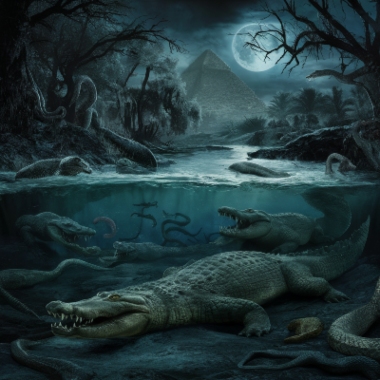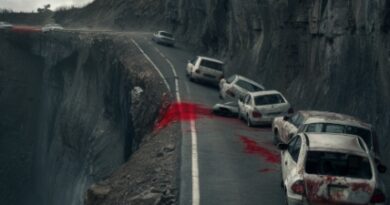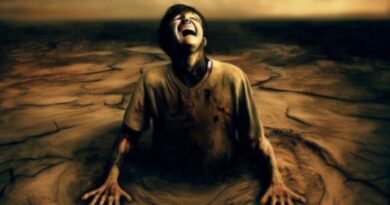Massacre On The Nile: The Dangreous Side Of The Nile River
Call me crazy, but as someone addicted to horror movies, I can’t help but imagine the texts we all grew up with as some horror monstrosity. In many, many cases, this happens. I don’t just mean the rather obnoxious trend of turning children’s fairy tales into horror films (because most movies made for this purpose are amateurish bad), but also classic historical stories. Let’s talk about the Bible, which offers tales of apparitions, demons, plagues, and other troubles. Many religious films and some films take horror elements into the contemporary world (like “The Reaping” with Hilary Swank). Still, we seem to be missing a few films that take a classic story from the Bible, make some changes, and turn the result into a horror movie. Maybe it’s too weird; some see it as “blasphemy.”
Take, for example, the story of Moses in the basket. As you may remember, according to this terrible story, Pharaoh ordered every Jewish baby to be thrown into the river, aka the Nile River, as part of the decrees. Pharaoh’s daughter plucked Little Moses from the water; the rest is history. We tell this story in the schools and on the evenings of the Seder night, describe the story that happened here. If we knew precisely what the dangers of the Nile River are, one of the scariest natural places in the world, we would understand how miraculous the story is. Because Moses is probably only a great leader, they could also be the hero of a horror movie called “The Final Baby” or something like that, about an extraordinary baby who may have survived the murderous efforts of the greatest serial killers that nature created.
Some Facts Of The Nile River
Before we talk about the scary sides of the Nile River – and you won’t believe how dangerous this place is – a short geography lesson about the facts of the Nile River. The first question you may ask is how long is The Nile River, and the simple answer is: Extremely long. The River is considered the longest in the world. The length of The Nile river is about 6,655 kilometers and the area of its drainage basin about 3.5 million square kilometers. The Nile has two primary sources, known as “The White Nile” (a section of the river that begins in equatorial Africa and is known for its ability to emerge from thick swamps when it is clean and clear. The second Nile River source is “The Blue Nile” (flowing from Lake Tana in Ethiopia and earned the nickname due to its dark water).
The Nile River makes up about a tenth of the surface of the African continent and passes through 11 countries on the Black Continent, up to its meeting point with the Mediterranean Sea. It is the primary water source in some African countries, such as Egypt and Sudan, known for arid conditions. Nile River The problem is that this is where things start to get complicated. Since ancient times, the Nile has been known for its repeated flooding. Attempts were made to regulate the water in the Nile following the repeated flooding, along with the need to control its various uses. Throughout history, people used the river for multiple purposes, such as irrigation, drinking, and maritime transport.
Among the boats that pass through it, you will find cruises and those that fit the definition of a “pleasure cruise,” which usually lasts a few days. In 1937, the book “Death on the Nile” by the British suspense artist Agatha Christie was published, which deals with a murder mystery during just such a cruise. In 2022, a film of the same name was also released, with a relatively large cast (which includes Kenneth Branagh, Gal Gadot, Emma Mackie, Rose Leslie, and others), which was quite mediocre.
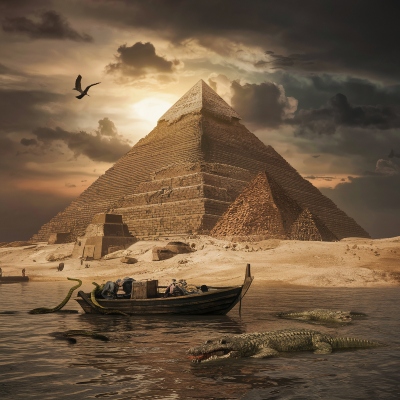
The Real Killers: Animals By The Nile River
So it is true that occasionally, in reality, or thrillers, murders occur on the Nile. But that is the least of the dangers lurking in this dangerous river. In large parts of the areas in the Nile, there is wild vegetation up to the level of tropical rainforests and savannahs. As far as we know, these plants are not dangerous, but they are fertile ground for a very long list of carnivorous animals you would not be happy to meet.
All this makes the Nile a river that is difficult to find and more dangerous in the world, up to the level of required comparisons with the Amazon River in South America.
The Nile River Crocodiles
We’ll start our list of dangerous animals by The Nile River with alligators, being surrounded by them can never be good. The first dangerous inhabitant of the Nile River, found mainly on its lower shores, is The Nile Crocodile. You surely don’t want to meet this enormous crocodile whose length can reach about 4-6 meters and weigh several hundred kilograms, sometimes even more than a ton.
How many crocodiles are in The Nile River? We don’t know for sure, but the ones you can find there are super deadly. The Nile River Crocodiles are considered a super predator, known for being a real killing machine. His favorite form of capture is an ambush in the water, with only his eyes and nostrils protruding slightly above the waterline (as you’ve probably seen in many alligator movies). Sensing a movement in the water, he will swim to his unfortunate victim quietly and then catch him at a tremendous speed that can reach up to 30 miles or 50 kilometers per hour.
The horror just starts here. The Nile crocodile will drag its victim into the water, drown it, bite it with tremendous force, dismember the body using the terrible “death roll” technique, and eat whole parts of it. According to estimates, around the Nile River, about 200 people a year end their lives in this awful way.
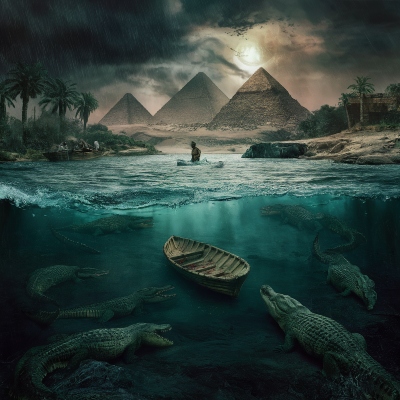
Snakes: The Black Mamba And The Rest
A central part of nature’s fear experience is snakes, manifested in places like Brazil’s super scary snake island. The Nile is a little more modest in its selection of snakes, but they are just as dangerous. You will find here about 30 varieties of snakes, more than half of which are particularly poisonous. The first example is the “Black Mamba,” a fast snake that is even slightly more dangerous than that Uma Thurman character in “Kill Bill,” who got that nickname.
The venom of the black mamba can kill a person in less than half an hour. If that’s not enough, this deadly snake also performs a “Dead Checking” to attack the person or animal more than once to ensure enough venom. You probably don’t want to run into the Egyptian cobra, a snake whose poison is said to kill even an elephant quickly. The venom of the Egyptian cobra paralyzes the victim to the point that he cannot breathe. There are also snakes that devour the victim whole (the Central African Rock Python), strangling snakes, and more.

Mosquitoes And Other Diseases
The Nile region is known for its extensive flying population, with a considerable emphasis on mosquitoes. The mosquitoes in different areas of the Nile can carry deadly diseases: among other things, West Nile fever and malaria, which in the past caused millions of deaths a year. Although in most cases, people who contract West Nile fever do not develop symptoms, there may be symptoms such as fever, headache, joint pain, and skin rash. In rarer cases, a disease develops that affects the nervous system, may cause inflammation in the brain, or even be life-threatening. To put it bluntly, in one year, about 500 million people worldwide get diseases caused by mosquito bites, and hundreds of thousands die from malaria and Nile fever.
the list of animals by The Nile River also includes turtles, lizards, hippos (which can be extremely deadly to humans when they sense danger), and other animals that, with a bit of imagination and poor animation, and no budget, could become a terrible horror film. Here, for example, is a stress-free video about the ten scariest animals living around the Nile.
Is The Nile River Dangerous Today?
It is important to emphasize that the list of dangers varies in every region of the Nile River, which, as mentioned, is enormous. The more tourist areas of the Nile are considered relatively safe, and of course, the big cities too: the Egyptian capital city of Cairo, for example, is located on the banks of the Nile River.
The development of these areas means that the probability of encountering all those murderous creatures is relatively low, even if you occasionally see reports of some dangerous animal spotted near a populated place. Those “predators” will prefer the remote and less populated areas, from which it is essential to stay away like a predatory crocodile. Of course, we would not recommend anyone to visit these areas because, after all – miracles like Moses’s probably only happened during the time of the Bible.
Should You Visit The Nile?
There are plenty of options for safe travel or cruises on the Nile, with departure points possibly being Cairo, Aswan, or Luxor. You can find a panoramic cruise that lasts a few hours, sometimes with a combination of dinner, entertainment, and other attractions, which can provide you with a particular taste of the landscapes and the area’s beauty.
You can also find cruise on The Nile River that lasts at least a few days. In most cases, these cruises combine a visit to the sites scattered around the Nile (for example, the Luxor Temple, the Valley of the Kings), exciting attractions along the way (such as a hot air balloon ride), and comfortable and sometimes pampering conditions on the cruise itself, for example, restaurants, swimming pools, and entertainment activities to all the family.
Of course, to avoid turning your visit to Egypt into a horror movie, it is essential to make some research before cruising The Nile River. Choose only skilled operators, with all the necessary safety permits and procedures. The cruises you will find on the major attraction sites meet this condition, and we recommend choosing a cruise with enough information, data, and positive reviews about it.
Here’s some recommended activities involving The Nile River:

